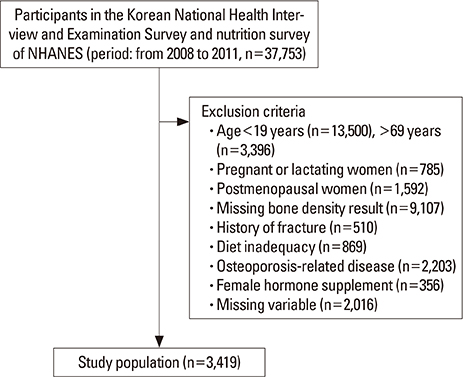J Bone Metab.
2016 Aug;23(3):143-148. 10.11005/jbm.2016.23.3.143.
Comparison in Adherence to Osteoporosis Guidelines according to Bone Health Status in Korean Adult
- Affiliations
-
- 1Department of Preventive Medicine, Soonchunhyang University College of Medicine, Cheonan, Korea. parky@sch.ac.kr
- 2Department of Clinical Nutrition, Soonchunhyang University Bucheon Hospital, Bucheon, Korea.
- 3Department of Food Sciences & Nutrition, Soonchunhyang University, Asan, Korea.
- 4Department of Obstetrics and Gynecology, Soonchunhyang University College of Medicine, Bucheon, Korea.
- 5Division of Endocrinology and Metabolism, Department of Internal Medicine, Soonchunhyang University Seoul Hospital, Seoul, Korea.
- KMID: 2350810
- DOI: http://doi.org/10.11005/jbm.2016.23.3.143
Abstract
- BACKGROUND
Osteoporosis one of the most serious disease to decrease the quality of life and cause economic loss. Thus, prevention of osteoporosis has become an important health concern. The study examined in adherence to osteoporosis guidelines and compared the levels of adherence to osteoporosis guidelines between bone health status in Korean adult.
METHODS
This study used data from a nationally represented sample of Koreans (n=3,419) from 2008 to 2011 Korea National Health and Nutrition Examination Survey. We were divided into three groups by T-score: normal, osteopenia and osteoporosis. Assessment of adherence level was based on 5 components of osteoporosis guidelines, considering intake of sodium, calcium and protein, smoking and regular exercise.
RESULTS
The sex, body mass index, income and educational level did not significantly differ between three groups. Deficient intake of calcium was significantly associated with a threefold greater odds in osteoporosis group (OR 3.6; 95% confidence interval [CI] 2.52-5.22). Excessive protein intake was significantly increased the risk only in osteoporosis group compared to the normal group (OR 1.71; 95% CI 1.15-2.62). Smoking increased the risk in osteoporosis group compared to the normal group (OR 2.88; 95% CI 1.75-4.76), osteoporosis group compared to the osteopenia group (OR 2.69; 95% CI 1.61-4.55).
CONCLUSIONS
Nutritional factor (intake of calcium and protein) and lifestyle-related factor (smoking and exercise) must be accompanied the management for bone health. An adherence of guidelines is considered very important for the prevention of osteoporosis.
Keyword
MeSH Terms
Figure
Cited by 1 articles
-
Relationship between Heavy Metal Exposure and Bone Mineral Density in Korean Adult
Hee-Sook Lim, Hae-Hyeog Lee, Tae-Hee Kim, Bo-Ra Lee
J Bone Metab. 2016;23(4):223-231. doi: 10.11005/jbm.2016.23.4.223.
Reference
-
1. Korean Society for Bone and Mineral Research. Physician's guide for diagnosis & treatment of osteoporosis. 2015. cited by. Available from: http://www.ksbmr.org/image/journal/골다공증%20지침서2015_final_1002.pdf.2. NIH Consensus Development Panel on Osteoporosis Prevention, Diagnosis, and Therapy. NIH consensus development panel on osteoporosis prevention, diagnosis, and therapy, March 7-29, 2000: highlights of the conference. South Med J. 2001; 94:569–573.3. Paek KS. Lifestyles and factors influencing the bone mineral density (BMD) among employees in a community. J Korean Acad Community Health Nurs. 2013; 24:236–244.
Article4. Kim Y, Kim JH, Cho DS. Gender difference in osteoporosis prevalence, awareness and treatment: based on the Korea national health and nutrition examination survey 2008-2011. J Korean Acad Nurs. 2015; 45:293–305.
Article5. Khadilkar AV, Mandlik RM. Epidemiology and treatment of osteoporosis in women: an Indian perspective. Int J Womens Health. 2015; 7:841–850.6. Wei X, Xu A, Yin Y, et al. The potential effect of Wuqinxi exercise for primary osteoporosis: a systematic review and meta-analysis. Maturitas. 2015; 82:346–354.
Article7. Lupsa BC, Insogna K. Bone health and osteoporosis. Endocrinol Metab Clin North Am. 2015; 44:517–530.
Article8. Lim YS, Lee SW, Tserendejid Z, et al. Prevalence of osteoporosis according to nutrient and food group intake levels in Korean postmenopausal women: using the 2010 Korea National Health and Nutrition Examination Survey Data. Nutr Res Pract. 2015; 9:539–546.
Article9. Yamauchi M. On "2015 guidelines for prevention and treatment of osteoporosis". Osteoporosis associated with lifestyle-related diseases: other lifestyle-related diseases. Clin Calcium. 2015; 25:1339–1346.10. Weaver CM, Alexander DD, Boushey CJ, et al. Calcium plus vitamin D supplementation and risk of fractures: an updated meta-analysis from the National Osteoporosis Foundation. Osteoporos Int. 2016; 27:367–376.
Article11. Kim KM, Choi HS, Choi MJ, et al. Calcium and vitamin D supplementations: 2015 position statement of the Korean Society for Bone and Mineral Research. J Bone Metab. 2015; 22:143–149.
Article12. Cohen AJ, Roe FJ. Review of risk factors for osteoporosis with particular reference to a possible aetiological role of dietary salt. Food Chem Toxicol. 2000; 38:237–253.
Article13. Manios Y, Moschonis G, Trovas G, et al. Changes in biochemical indexes of bone metabolism and bone mineral density after a 12-mo dietary intervention program: the Postmenopausal Health Study. Am J Clin Nutr. 2007; 86:781–789.
Article14. Jørgensen L, Joakimsen R, Ahmed L, et al. Smoking is a strong risk factor for non-vertebral fractures in women with diabetes: the Tromso Study. Osteoporos Int. 2011; 22:1247–1253.
Article15. Korpelainen R, Korpelainen J, Heikkinen J, et al. Lifestyle factors are associated with osteoporosis in lean women but not in normal and overweight women: a population-based cohort study of 1222 women. Osteoporos Int. 2003; 14:34–43.
Article16. Ministry of Health and Welfare. The Korean Nutrition Society. Dietary reference intakes for Koreans 2015. Sejong: Ministry of Health and Welfare;2015.17. Lim HS, Park YH, Lee HH, et al. Comparison of calcium intake status by region and socioeconomic status in Korea: The 2011-2013 Korea National Health and Nutrition Examination Survey. J Bone Metab. 2015; 22:119–126.
Article18. Meleleo D, Picciarelli V. Effect of calcium ions on human calcitonin. Possible implications for bone resorption by osteoclasts. Biometals. 2016; 29:61–79.
Article
- Full Text Links
- Actions
-
Cited
- CITED
-
- Close
- Share
- Similar articles
-
- Analysis of Adherence of Once-yearly Intravenous Zolendronic Acid for Osteoporosis
- Analysis of the Adherence in Once Yearly Intravenous Zoledronic Acid
- New Antiresorptive Therapies for Postmenopausal Osteoporosis
- Effects of the Knowledge, Health Belief, and Self-Efficacy about Osteoporosis on Calcium Intake Behavior for Postmenopausal Osteoporosis Patients
- Treatment of Osteoporosis: Unmet Needs and Emerging Solutions


